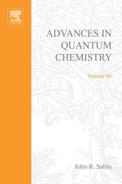Table of Contents
Half a Century Of Hybridization
1 Introduction : A perennial concept
2 Theoretical determination methods of hybrid orbitals
3 Conclusions : A multiple-purpose instrument
Core and valence electrons in atom-by-atom descriptions of molecules
Dedication and Acknowledgements
From Classical Density Functionals to Adiabatic Connection Methods. The State of the Art.
Exchange-Energy Density Functionals as Linear Combinations of Homogeneous Functionals of Density
II Theory: Exchange-Energy Density Functional
2 Electrostatic solvent effects within the CS INDO scheme
4 Transition Structures and Activation Parameters
6 Comparison with the experimental results
7 Origin of Endo/Exo Selectivity: Analysis of TS Structures
8 Origin of Endo/Exo Selectivity: Analysis of Activation Barriers
Solvent-mediated proton transfer reactions in cytosine: an ab initio study
Electron correlation at the dawn of the 21st century
2 Electron correlation in very small atoms and molecules
3 Many-electron methods in terms of one-electron basis sets
4 The convergence with the basis size and the R12 method
5 Localized correlation methods
3 Almost–Linear (AL) CC Methods
The half projected hartree-fock model for determining singlet excited states.
2 THE HPHF FUNCTION FOR THE SINGLET GROUND STATE
3 THE HPHF EQUATIONS FOR EXCITED STATES
Complexation of transition metal cations (Sc+, Fe+, Cu+) by one cyanide radical
1 Monocoordinated complexes as molecular models and chemical species
2 Quantum-mechanical predictions
3 Final remarks on the complexation by the CN ligand
On the Photophysics of Molecules with Charge-Transfer Excitations between aromatic rings
2 Biaryls and related molecules
Proton Assisted Electron Transfer
Proton assisted electron transfer
Dynamical features of the PA-ET mechanism
Lanczos calculation of the ![]() nonadiabatic Franck-Condon absorption spectrum of NO2
nonadiabatic Franck-Condon absorption spectrum of NO2
Hyperspherical coordinates for chemical reaction dynamics
2 Separation of radial and angular variables. Orbital angular momentum.
3 Near separability. Adiabatic and diabatic representations.
4 Three-body problem. Orbital and rotational angular momentum.
5 Hyperspherical coordinates and harmonics. Hyperangular momentum.
6 Hyperspherical mapping of potential energy surfaces. Alternative parametrization of hyperangles.
7 Perspectives and concluding remarks.
On the Einstein-Podolsky-Rosen Paradox
3) Reduced density matrices; spin correlation
